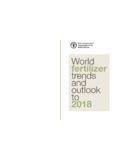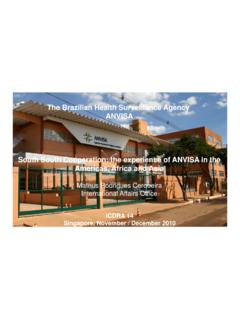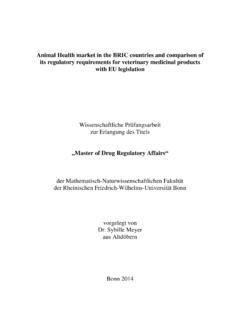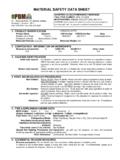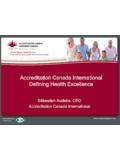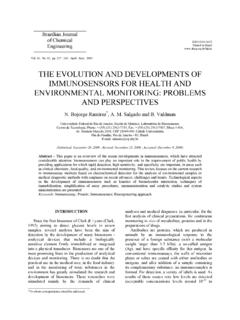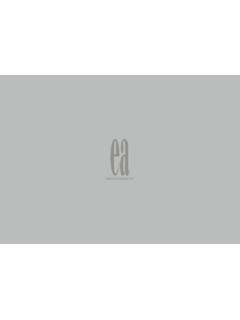Transcription of i1379e - Good Practices for the Feed Industry ...
1 ISSN 1810-1119. 9. FAO ANIMAL PRODUCTION AND health . manual GOOD Practices . FOR THE FEED Industry . Implementing the Codex Alimentarius Code of Practice on Good Animal Feeding 9. FAO ANIMAL PRODUCTION AND health . manual GOOD Practices . FOR THE FEED Industry . Implementing the Codex Alimentarius Code of Practice on Good Animal Feeding FOOD AND AGRICULTURE ORGANIZATION OF THE UNTIED NATIONS. FOOD AND AGRICULTURE. ANDORGANIZATION OF THE. INTERNATIONAL FEED UNITEDFEDERATION. Industry NATIONS. Rome, 2010. 2010. Recommended Citation FAO and IFIF. 2010. Good Practices for the feed Industry Implementing the Codex Alimentarius Code of Practice on Good Animal Feeding. FAO Animal Production and health Manual No. 9. Rome. The designations employed and the presentation of material in this publication do not imply the expression of any opinion whatsoever on the part of the Food and Agriculture Organization of the United Nations, or of IFIF concerning the legal status of any country, territory, city or area or of its authorities, or concerning the delimitation of its frontiers or boundaries.
2 The mention of specific companies or products of manufacturers, whether or not these have been patented, does not imply that these have been endorsed or recommended by FAO, or IFIF in preference to others of a similar nature that are not mentioned. The views expressed herein are those of the authors and do not necessarily represent those of FAO, or the IFIF. ISBN 978-92-5-106487-0. All rights reserved. Reproduction and dissemination of material in this information product for educational or other non-commercial purposes are authorized without any prior written permission of the copyright. Applications for such permission should be addressed to the Chief Publishing Policy and Support Branch Office of Knowledge, Research and Extension FAO. Viale delle Terme di Caracalla 00153 Rome Italy or by e-mail to: FAO, 2010. iii Contents Foreword - FAO iv Foreword - IFIF v Introduction vii Glossary ix Feed Industry terms xii Feed ingredient terms xviii Abbreviations & Acronyms xix SECTION 1.
3 health hazards associated with animal feed 1 Section 2. General principles and requirements 7. Section 3. Good production Practices 19. Section 4. On-farm production and use of feed and feed ingredients 37. Section 5. Methods of sampling and analysis 51. Appendix I. The Codex Code of Practice for Good Animal Feeding 59. Appendix II. National codes of practice 69. Appendix III. The role of national feed associations and setting up a feed association 73. iv Foreword FAO. Synergizing good Practices on animal feed Delgado et al. (1999) used the term Livestock Revolution' to describe the rapid growth of the global livestock sector in response to the increase in demand for food of animal origin which they said has profound implications for human health , livelihoods and the environment.. Livestock production is growing fastest in the developing world, particularly in Asia and Latin America. Increased output has been achieved mainly through the intensification of production sys- tems and through a shift towards poultry and pigs with much slower expansion of beef production.
4 Dairying too has increased in both scale and intensification. The industrialisation of livestock produc- tion systems, characterized by high animal densities and limited land base for the recycling of manure and other waste in crop agriculture, are associated with substantial environmental externalities and require particular attention to biosecurity, animal disease emergence and control as well as to animal welfare and domestic animal diversity management. Good Agricultural Practices (GAP) and good Practices in assessing, managing and communicating risks along the entire food chain are required. Such Practices need to respect conditions of economic, environmental and social sustainability and to be geared towards protecting food safety and veteri- nary public health . FAO assigns high priority to the development of good agricultural and manage- ment Practices in livestock production and animal health ; their application in the livestock sector relies on the active involvement of the sector itself in the design of such Practices .
5 The close collaboration of Industry and inter-governmental agencies such as FAO in this endeavour is key for achieving the desired impact. Food safety is a core area of the collaboration of all actors, private and public, for the protection of the animal product food chain from the farm to the consumer. Given the direct links between animal feed and the safety of foods of animal origin, it is essential that feed production and manufacture are considered as an integral part of the food production chain. Feed production must therefore be sub- ject, in the same way as food production, to the quality assurance of integrated food safety systems. The Joint FAO/WHO Codex Alimentarius Commission approved three important Codes affecting livestock production: the Code of Practice for Good Animal Feeding, the Code of Hygienic Practice for Meat and the Code of Hygienic Practice for Milk and Milk Products. FAO is determined to assist in the practical implementation of these Codes across the sector by bringing together the relevant actors in the animal feed and animal production, processing and retail chain to address the critical issues of food safety and sustainable development.
6 The close collaboration between FAO and the sector's relevant players, such as the International Feed Industry Federation (IFIF) in the case of the design, production and introduction of this Manual of Good Practices for the Feed Industry is instrumental for achieving these important objectives. Samuel Jutzi Director - Animal Production and health Division Food and Agriculture Organization of the United Nations (FAO). Rome, Italy Delgado, C., Rosegrant, M., Steinfeld, H., Ehui, S. and Courbois C. 1999 Livestock to 2020: The Next Food Revolution. International Food Policy Research Institute, Food, Agriculture,and the Environment Discussion Paper No. 28, 72 pp. v Foreword IFIF. Our industries should embrace this worthy endeavour For the first time ever, the feed Industry has developed an international Feed Manual that focuses on the issues of feed and food safety. Joining together to make this happen are the International Feed Industry Federation (IFIF) and the Food and Agriculture Organization of the United Nations (FAO).
7 This initiative has been assisted through the WTO-supported Standards and Trade Development Facility (STDF). The undertaking is certainly no small task, but with the recent adoption of the Codex Alimentarius Code of Practice on Good Animal Feeding, a manual that explains in detail these new requirements is a worthy endeavor and one which the world's feed and food industries should fully embrace and provide their complete support. The Manual consists of five sections, explaining in detail how those involved in the production of animal feeds can implement the principles documented in the Codex Alimentarius' Code of Practice on Good Animal Feeding. While it is not meant to be an all-inclusive document, this Feed Manual focuses on the issues of feed and food safety and carries with it a set of Appendices which contains the Code itself and additional supporting information related to the manufacture of safe feed. Also covered in body of the Manual is safe feeding Practices for on-farm feeding (Section 4).
8 The International Feed Industry Federation aims to help meet the demand for safe and affordable food globally, through its membership, by: Promoting a range of processing technologies and engineering in feed manufacture, from processes relying on general and skilled labor to fully automated manufacturing systems Making use of a wide range of co-products, by-products and raw materials from primary agricultural production, the food Industry and industrial sources Sponsoring university research in animal nutrition and other fields and conducting feeding and animal husbandry trials Developing systems of feed marketing and distribution to support livestock farming in markets that span the globe Playing a proactive role in educating feed manufacturers, consumers and regulatory authorities worldwide on a variety of issues that affect the supply of safe and affordable foods of animal origin. While all are of significant importance, it is the last of these five goals that is key and helps take the accomplishment of Codex Alimentarius and its new feed standard beyond our Industry to provide consumers with the assurances for which they are increasingly looking for in regard to the safety of their food.
9 Safety is important for the expansion of international trade in feed products as well as food pro- ducts of animal origin. Both food exporting and importing countries, which include virtually every country, can benefit from a more level playing field to support the trade of safe food products. Fred Stephens Dave Cieslak President (2002-2008) Chairman (2008-onwards). International Feed Industry Federation (IFIF) International Feed Industry Federation (IFIF). Cheltenham, UK Cheltenham, UK. vi Acknowledgements Members of the International Feed Industry Federation (IFIF). have substantially collaborated with the Food and Agriculture Organization of the United Nations (FAO) in the production of this manual. In particular IFIF and FAO wish to acknowledge the contributions made by: IFIF national Feed Associations, universities and feed Industry members for significant contributions to drafting the manual. Primary contacts include Ariovaldo Zanni, Flavia Ferreira de Castro, Angela Pellegrino Missaglia and Dario Righi of the Brazilian Feed Industry Association (Sindira es), Richard Sellers and Dave Bossman of the American Feed Association (AFIA), Honjie Yang of the China Feed Industry Association (CFIA), Alexander D ring of the European Feed Manufacturers Federation (FEFAC), DeWitt Boshoff of the African Feed Millers Association (AFMA), Tim Herrman of Texas A&M.
10 University, George Kau of DSM, Karine Tanan of Provimi, Steve Auman of Potash Corporation of Canada and chairman of IFIF's Technical and Regulatory Committee and Roger Gilbert, Secretary General of IFIF. Grateful acknowledgement is given to all of these people and organizations for supplying relevant input for the various chapters. Several staff within the Nutrition and Consumer Protection Division and in the Animal Production and health Division of the Agriculture and Consumer Protection Department of FAO, contributed to the technical review of the material. Section 1 has been adapted and reprinted from the Report of the FAO/WHO Expert Meeting on Animal Feed Impact on Food Safety (2007). The production of the manual has been realized with the financial contribution of the Standard and Trade Development Facility (STDF) of the FAO, the World Organisation for Animal health (OIE), the World Bank Group, the World health Organization (WHO) and the World Trade Organization (WTO).









